|
Carbon dioxide
Carbon dioxide is a chemical compound with the chemical formula CO2. It is made up of molecules that each have one carbon atom covalently double bonded to two oxygen atoms. It is found in the gas state at room temperature and at normally-encountered concentrations it is odorless. As the source of carbon in the carbon cycle, atmospheric CO2 is the primary carbon source for life on Earth. In the air, carbon dioxide is transparent to visible light but absorbs infrared radiation, acting as a greenhouse gas. Carbon dioxide is soluble in water and is found in groundwater, lakes, ice caps, and seawater. It is a trace gas in Earth's atmosphere at 421 parts per million (ppm),[a] or about 0.042% (as of May 2022) having risen from pre-industrial levels of 280 ppm or about 0.028%.[10][11] Burning fossil fuels is the main cause of these increased CO2 concentrations, which are the primary cause of climate change.[12] Its concentration in Earth's pre-industrial atmosphere since late in the Precambrian was regulated by organisms and geological features. Plants, algae and cyanobacteria use energy from sunlight to synthesize carbohydrates from carbon dioxide and water in a process called photosynthesis, which produces oxygen as a waste product.[13] In turn, oxygen is consumed and CO2 is released as waste by all aerobic organisms when they metabolize organic compounds to produce energy by respiration.[14] CO2 is released from organic materials when they decay or combust, such as in forest fires. When carbon dioxide dissolves in water, it forms carbonate and mainly bicarbonate (HCO−3), which causes ocean acidification as atmospheric CO2 levels increase.[15] Carbon dioxide is 53% more dense than dry air, but is long lived and thoroughly mixes in the atmosphere. About half of excess CO2 emissions to the atmosphere are absorbed by land and ocean carbon sinks.[16] These sinks can become saturated and are volatile, as decay and wildfires result in the CO2 being released back into the atmosphere.[17] CO2 is eventually sequestered (stored for the long term) in rocks and organic deposits like coal, petroleum and natural gas. Nearly all CO2 produced by humans goes into the atmosphere. Less than 1% of CO2 produced annually is put to commercial use, mostly in the fertilizer industry and in the oil and gas industry for enhanced oil recovery. Other commercial applications include food and beverage production, metal fabrication, cooling, fire suppression and stimulating plant growth in greenhouses.[18]: 3 Chemical and physical propertiesStructure, bonding and molecular vibrationsThe symmetry of a carbon dioxide molecule is linear and centrosymmetric at its equilibrium geometry. The length of the carbon–oxygen bond in carbon dioxide is 116.3 pm, noticeably shorter than the roughly 140 pm length of a typical single C–O bond, and shorter than most other C–O multiply bonded functional groups such as carbonyls.[19] Since it is centrosymmetric, the molecule has no electric dipole moment.  As a linear triatomic molecule, CO2 has four vibrational modes as shown in the diagram. In the symmetric and the antisymmetric stretching modes, the atoms move along the axis of the molecule. There are two bending modes, which are degenerate, meaning that they have the same frequency and same energy, because of the symmetry of the molecule. When a molecule touches a surface or touches another molecule, the two bending modes can differ in frequency because the interaction is different for the two modes. Some of the vibrational modes are observed in the infrared (IR) spectrum: the antisymmetric stretching mode at wavenumber 2349 cm−1 (wavelength 4.25 μm) and the degenerate pair of bending modes at 667 cm−1 (wavelength 15.0 μm). The symmetric stretching mode does not create an electric dipole so is not observed in IR spectroscopy, but it is detected in Raman spectroscopy at 1388 cm−1 (wavelength 7.20 μm), with a Fermi resonance doublet at 1285 cm−1.[20] In the gas phase, carbon dioxide molecules undergo significant vibrational motions and do not keep a fixed structure. However, in a Coulomb explosion imaging experiment, an instantaneous image of the molecular structure can be deduced. Such an experiment[21] has been performed for carbon dioxide. The result of this experiment, and the conclusion of theoretical calculations[22] based on an ab initio potential energy surface of the molecule, is that none of the molecules in the gas phase are ever exactly linear. This counter-intuitive result is trivially due to the fact that the nuclear motion volume element vanishes for linear geometries.[22] This is so for all molecules except diatomic molecules. In aqueous solutionCarbon dioxide is soluble in water, in which it reversibly forms H2CO3 (carbonic acid), which is a weak acid, because its ionization in water is incomplete.
The hydration equilibrium constant of carbonic acid is, at 25 °C: Hence, the majority of the carbon dioxide is not converted into carbonic acid, but remains as CO2 molecules, not affecting the pH. The relative concentrations of CO2, H2CO3, and the deprotonated forms HCO−3 (bicarbonate) and CO2−3(carbonate) depend on the pH. As shown in a Bjerrum plot, in neutral or slightly alkaline water (pH > 6.5), the bicarbonate form predominates (>50%) becoming the most prevalent (>95%) at the pH of seawater. In very alkaline water (pH > 10.4), the predominant (>50%) form is carbonate. The oceans, being mildly alkaline with typical pH = 8.2–8.5, contain about 120 mg of bicarbonate per liter. Being diprotic, carbonic acid has two acid dissociation constants, the first one for the dissociation into the bicarbonate (also called hydrogen carbonate) ion (HCO−3):
This is the true first acid dissociation constant, defined as where the denominator includes only covalently bound H2CO3 and does not include hydrated CO2(aq). The much smaller and often-quoted value near 4.16 × 10−7 (or pKa1 = 6.38) is an apparent value calculated on the (incorrect) assumption that all dissolved CO2 is present as carbonic acid, so that Since most of the dissolved CO2 remains as CO2 molecules, Ka1(apparent) has a much larger denominator and a much smaller value than the true Ka1.[23] The bicarbonate ion is an amphoteric species that can act as an acid or as a base, depending on pH of the solution. At high pH, it dissociates significantly into the carbonate ion (CO2−3):
In organisms, carbonic acid production is catalysed by the enzyme known as carbonic anhydrase. In addition to altering its acidity, the presence of carbon dioxide in water also affects its electrical properties. 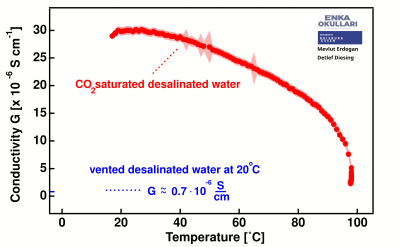 When carbon dioxide dissolves in desalinated water, the electrical conductivity increases significantly from below 1 μS/cm to nearly 30 μS/cm. When heated, the water begins to gradually lose the conductivity induced by the presence of , especially noticeable as temperatures exceed 30 °C. The temperature dependence of the electrical conductivity of fully deionized water without CO2 saturation is comparably low in relation to these data. Chemical reactionsCO2 is a potent electrophile having an electrophilic reactivity that is comparable to benzaldehyde or strongly electrophilic α,β-unsaturated carbonyl compounds. However, unlike electrophiles of similar reactivity, the reactions of nucleophiles with CO2 are thermodynamically less favored and are often found to be highly reversible.[24] The reversible reaction of carbon dioxide with amines to make carbamates is used in CO2 scrubbers and has been suggested as a possible starting point for carbon capture and storage by amine gas treating. Only very strong nucleophiles, like the carbanions provided by Grignard reagents and organolithium compounds react with CO2 to give carboxylates: In metal carbon dioxide complexes, CO2 serves as a ligand, which can facilitate the conversion of CO2 to other chemicals.[25] The reduction of CO2 to CO is ordinarily a difficult and slow reaction:
The redox potential for this reaction near pH 7 is about −0.53 V versus the standard hydrogen electrode. The nickel-containing enzyme carbon monoxide dehydrogenase catalyses this process.[26] Photoautotrophs (i.e. plants and cyanobacteria) use the energy contained in sunlight to photosynthesize simple sugars from CO2 absorbed from the air and water:
Physical properties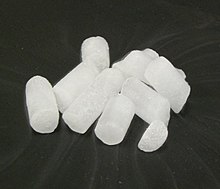 Carbon dioxide is colorless. At low concentrations, the gas is odorless; however, at sufficiently high concentrations, it has a sharp, acidic odor.[1] At standard temperature and pressure, the density of carbon dioxide is around 1.98 kg/m3, about 1.53 times that of air.[27] Carbon dioxide has no liquid state at pressures below 0.51795(10) MPa[2] (5.11177(99) atm). At a pressure of 1 atm (0.101325 MPa), the gas deposits directly to a solid at temperatures below 194.6855(30) K[2] (−78.4645(30) °C) and the solid sublimes directly to a gas above this temperature. In its solid state, carbon dioxide is commonly called dry ice.  Liquid carbon dioxide forms only at pressures above 0.51795(10) MPa[2] (5.11177(99) atm); the triple point of carbon dioxide is 216.592(3) K[2] (−56.558(3) °C) at 0.51795(10) MPa[2] (5.11177(99) atm) (see phase diagram). The critical point is 304.128(15) K[2] (30.978(15) °C) at 7.3773(30) MPa[2] (72.808(30) atm). Another form of solid carbon dioxide observed at high pressure is an amorphous glass-like solid.[28] This form of glass, called carbonia, is produced by supercooling heated CO2 at extreme pressures (40–48 GPa, or about 400,000 atmospheres) in a diamond anvil. This discovery confirmed the theory that carbon dioxide could exist in a glass state similar to other members of its elemental family, like silicon dioxide (silica glass) and germanium dioxide. Unlike silica and germania glasses, however, carbonia glass is not stable at normal pressures and reverts to gas when pressure is released. At temperatures and pressures above the critical point, carbon dioxide behaves as a supercritical fluid known as supercritical carbon dioxide. Table of thermal and physical properties of saturated liquid carbon dioxide:[29][30]
Table of thermal and physical properties of carbon dioxide (CO2) at atmospheric pressure:[29][30]
Biological roleCarbon dioxide is an end product of cellular respiration in organisms that obtain energy by breaking down sugars, fats and amino acids with oxygen as part of their metabolism. This includes all plants, algae and animals and aerobic fungi and bacteria. In vertebrates, the carbon dioxide travels in the blood from the body's tissues to the skin (e.g., amphibians) or the gills (e.g., fish), from where it dissolves in the water, or to the lungs from where it is exhaled. During active photosynthesis, plants can absorb more carbon dioxide from the atmosphere than they release in respiration. Photosynthesis and carbon fixation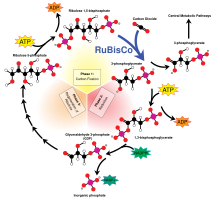 Carbon fixation is a biochemical process by which atmospheric carbon dioxide is incorporated by plants, algae and cyanobacteria into energy-rich organic molecules such as glucose, thus creating their own food by photosynthesis. Photosynthesis uses carbon dioxide and water to produce sugars from which other organic compounds can be constructed, and oxygen is produced as a by-product. Ribulose-1,5-bisphosphate carboxylase oxygenase, commonly abbreviated to RuBisCO, is the enzyme involved in the first major step of carbon fixation, the production of two molecules of 3-phosphoglycerate from CO2 and ribulose bisphosphate, as shown in the diagram at left. RuBisCO is thought to be the single most abundant protein on Earth.[31] Phototrophs use the products of their photosynthesis as internal food sources and as raw material for the biosynthesis of more complex organic molecules, such as polysaccharides, nucleic acids, and proteins. These are used for their own growth, and also as the basis of the food chains and webs that feed other organisms, including animals such as ourselves. Some important phototrophs, the coccolithophores synthesise hard calcium carbonate scales.[32] A globally significant species of coccolithophore is Emiliania huxleyi whose calcite scales have formed the basis of many sedimentary rocks such as limestone, where what was previously atmospheric carbon can remain fixed for geological timescales. 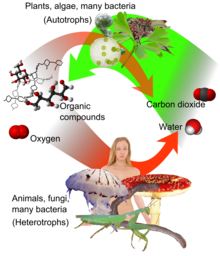 Plants can grow as much as 50% faster in concentrations of 1,000 ppm CO2 when compared with ambient conditions, though this assumes no change in climate and no limitation on other nutrients.[33] Elevated CO2 levels cause increased growth reflected in the harvestable yield of crops, with wheat, rice and soybean all showing increases in yield of 12–14% under elevated CO2 in FACE experiments.[34][35] Increased atmospheric CO2 concentrations result in fewer stomata developing on plants[36] which leads to reduced water usage and increased water-use efficiency.[37] Studies using FACE have shown that CO2 enrichment leads to decreased concentrations of micronutrients in crop plants.[38] This may have knock-on effects on other parts of ecosystems as herbivores will need to eat more food to gain the same amount of protein.[39] The concentration of secondary metabolites such as phenylpropanoids and flavonoids can also be altered in plants exposed to high concentrations of CO2.[40][41] Plants also emit CO2 during respiration, and so the majority of plants and algae, which use C3 photosynthesis, are only net absorbers during the day. Though a growing forest will absorb many tons of CO2 each year, a mature forest will produce as much CO2 from respiration and decomposition of dead specimens (e.g., fallen branches) as is used in photosynthesis in growing plants.[42] Contrary to the long-standing view that they are carbon neutral, mature forests can continue to accumulate carbon[43] and remain valuable carbon sinks, helping to maintain the carbon balance of Earth's atmosphere. Additionally, and crucially to life on earth, photosynthesis by phytoplankton consumes dissolved CO2 in the upper ocean and thereby promotes the absorption of CO2 from the atmosphere.[44] Toxicity Carbon dioxide content in fresh air (averaged between sea-level and 10 kPa level, i.e., about 30 km (19 mi) altitude) varies between 0.036% (360 ppm) and 0.041% (412 ppm), depending on the location.[46] In humans, exposure to CO2 at concentrations greater than 5% causes the development of hypercapnia and respiratory acidosis.[47] Concentrations of 7% to 10% (70,000 to 100,000 ppm) may cause suffocation, even in the presence of sufficient oxygen, manifesting as dizziness, headache, visual and hearing dysfunction, and unconsciousness within a few minutes to an hour.[48] Concentrations of more than 10% may cause convulsions, coma, and death. CO2 levels of more than 30% act rapidly leading to loss of consciousness in seconds.[47] Because it is heavier than air, in locations where the gas seeps from the ground (due to sub-surface volcanic or geothermal activity) in relatively high concentrations, without the dispersing effects of wind, it can collect in sheltered/pocketed locations below average ground level, causing animals located therein to be suffocated. Carrion feeders attracted to the carcasses are then also killed. Children have been killed in the same way near the city of Goma by CO2 emissions from the nearby volcano Mount Nyiragongo.[49] The Swahili term for this phenomenon is mazuku.  Adaptation to increased concentrations of CO2 occurs in humans, including modified breathing and kidney bicarbonate production, in order to balance the effects of blood acidification (acidosis). Several studies suggested that 2.0 percent inspired concentrations could be used for closed air spaces (e.g. a submarine) since the adaptation is physiological and reversible, as deterioration in performance or in normal physical activity does not happen at this level of exposure for five days.[50][51] Yet, other studies show a decrease in cognitive function even at much lower levels.[52][53] Also, with ongoing respiratory acidosis, adaptation or compensatory mechanisms will be unable to reverse the condition. Below 1%There are few studies of the health effects of long-term continuous CO2 exposure on humans and animals at levels below 1%. Occupational CO2 exposure limits have been set in the United States at 0.5% (5000 ppm) for an eight-hour period.[54] At this CO2 concentration, International Space Station crew experienced headaches, lethargy, mental slowness, emotional irritation, and sleep disruption.[55] Studies in animals at 0.5% CO2 have demonstrated kidney calcification and bone loss after eight weeks of exposure.[56] A study of humans exposed in 2.5 hour sessions demonstrated significant negative effects on cognitive abilities at concentrations as low as 0.1% (1000 ppm) CO2 likely due to CO2 induced increases in cerebral blood flow.[52] Another study observed a decline in basic activity level and information usage at 1000 ppm, when compared to 500 ppm.[53] However a review of the literature found that a reliable subset of studies on the phenomenon of carbon dioxide induced cognitive impairment to only show a small effect on high-level decision making (for concentrations below 5000 ppm). Most of the studies were confounded by inadequate study designs, environmental comfort, uncertainties in exposure doses and differing cognitive assessments used.[57] Similarly a study on the effects of the concentration of CO2 in motorcycle helmets has been criticized for having dubious methodology in not noting the self-reports of motorcycle riders and taking measurements using mannequins. Further when normal motorcycle conditions were achieved (such as highway or city speeds) or the visor was raised the concentration of CO2 declined to safe levels (0.2%).[58][59]
Ventilation Poor ventilation is one of the main causes of excessive CO2 concentrations in closed spaces, leading to poor indoor air quality. Carbon dioxide differential above outdoor concentrations at steady state conditions (when the occupancy and ventilation system operation are sufficiently long that CO2 concentration has stabilized) are sometimes used to estimate ventilation rates per person.[61] Higher CO2 concentrations are associated with occupant health, comfort and performance degradation.[62][63] ASHRAE Standard 62.1–2007 ventilation rates may result in indoor concentrations up to 2,100 ppm above ambient outdoor conditions. Thus if the outdoor concentration is 400 ppm, indoor concentrations may reach 2,500 ppm with ventilation rates that meet this industry consensus standard. Concentrations in poorly ventilated spaces can be found even higher than this (range of 3,000 or 4,000 ppm). Miners, who are particularly vulnerable to gas exposure due to insufficient ventilation, referred to mixtures of carbon dioxide and nitrogen as "blackdamp", "choke damp" or "stythe". Before more effective technologies were developed, miners would frequently monitor for dangerous levels of blackdamp and other gases in mine shafts by bringing a caged canary with them as they worked. The canary is more sensitive to asphyxiant gases than humans, and as it became unconscious would stop singing and fall off its perch. The Davy lamp could also detect high levels of blackdamp (which sinks, and collects near the floor) by burning less brightly, while methane, another suffocating gas and explosion risk, would make the lamp burn more brightly. In February 2020, three people died from suffocation at a party in Moscow when dry ice (frozen CO2) was added to a swimming pool to cool it down.[64] A similar accident occurred in 2018 when a woman died from CO2 fumes emanating from the large amount of dry ice she was transporting in her car.[65] Indoor airHumans spend more and more time in a confined atmosphere (around 80-90% of the time in a building or vehicle). According to the French Agency for Food, Environmental and Occupational Health & Safety (ANSES) and various actors in France, the CO2 rate in the indoor air of buildings (linked to human or animal occupancy and the presence of combustion installations), weighted by air renewal, is "usually between about 350 and 2,500 ppm".[66] In homes, schools, nurseries and offices, there are no systematic relationships between the levels of CO2 and other pollutants, and indoor CO2 is statistically not a good predictor of pollutants linked to outdoor road (or air, etc.) traffic.[67] CO2 is the parameter that changes the fastest (with hygrometry and oxygen levels when humans or animals are gathered in a closed or poorly ventilated room). In poor countries, many open hearths are sources of CO2 and CO emitted directly into the living environment.[68] Outdoor areas with elevated concentrationsLocal concentrations of carbon dioxide can reach high values near strong sources, especially those that are isolated by surrounding terrain. At the Bossoleto hot spring near Rapolano Terme in Tuscany, Italy, situated in a bowl-shaped depression about 100 m (330 ft) in diameter, concentrations of CO2 rise to above 75% overnight, sufficient to kill insects and small animals. After sunrise the gas is dispersed by convection.[69] High concentrations of CO2 produced by disturbance of deep lake water saturated with CO2 are thought to have caused 37 fatalities at Lake Monoun, Cameroon in 1984 and 1700 casualties at Lake Nyos, Cameroon in 1986.[70] Human physiologyContent
The body produces approximately 2.3 pounds (1.0 kg) of carbon dioxide per day per person,[72] containing 0.63 pounds (290 g) of carbon. In humans, this carbon dioxide is carried through the venous system and is breathed out through the lungs, resulting in lower concentrations in the arteries. The carbon dioxide content of the blood is often given as the partial pressure, which is the pressure which carbon dioxide would have had if it alone occupied the volume.[73] In humans, the blood carbon dioxide contents are shown in the adjacent table. Transport in the bloodCO2 is carried in blood in three different ways. Exact percentages vary between arterial and venous blood.
Hemoglobin, the main oxygen-carrying molecule in red blood cells, carries both oxygen and carbon dioxide. However, the CO2 bound to hemoglobin does not bind to the same site as oxygen. Instead, it combines with the N-terminal groups on the four globin chains. However, because of allosteric effects on the hemoglobin molecule, the binding of CO2 decreases the amount of oxygen that is bound for a given partial pressure of oxygen. This is known as the Haldane Effect, and is important in the transport of carbon dioxide from the tissues to the lungs. Conversely, a rise in the partial pressure of CO2 or a lower pH will cause offloading of oxygen from hemoglobin, which is known as the Bohr effect. Regulation of respirationCarbon dioxide is one of the mediators of local autoregulation of blood supply. If its concentration is high, the capillaries expand to allow a greater blood flow to that tissue.[75] Bicarbonate ions are crucial for regulating blood pH. A person's breathing rate influences the level of CO2 in their blood. Breathing that is too slow or shallow causes respiratory acidosis, while breathing that is too rapid leads to hyperventilation, which can cause respiratory alkalosis.[76] Although the body requires oxygen for metabolism, low oxygen levels normally do not stimulate breathing. Rather, breathing is stimulated by higher carbon dioxide levels. As a result, breathing low-pressure air or a gas mixture with no oxygen at all (such as pure nitrogen) can lead to loss of consciousness without ever experiencing air hunger. This is especially perilous for high-altitude fighter pilots. It is also why flight attendants instruct passengers, in case of loss of cabin pressure, to apply the oxygen mask to themselves first before helping others; otherwise, one risks losing consciousness.[74] The respiratory centers try to maintain an arterial CO2 pressure of 40 mmHg. With intentional hyperventilation, the CO2 content of arterial blood may be lowered to 10–20 mmHg (the oxygen content of the blood is little affected), and the respiratory drive is diminished. This is why one can hold one's breath longer after hyperventilating than without hyperventilating. This carries the risk that unconsciousness may result before the need to breathe becomes overwhelming, which is why hyperventilation is particularly dangerous before free diving.[77] Concentrations and role in the environmentAtmosphere In Earth's atmosphere, carbon dioxide is a trace gas that plays an integral part in the greenhouse effect, carbon cycle, photosynthesis and oceanic carbon cycle. It is one of three main greenhouse gases in the atmosphere of Earth. The concentration of carbon dioxide (CO2) in the atmosphere reached 427 ppm (0.0427%) on a molar basis in 2024, representing 3341 gigatonnes of CO2.[78] This is an increase of 50% since the start of the Industrial Revolution, up from 280 ppm during the 10,000 years prior to the mid-18th century.[79][80][81] The increase is due to human activity.[82] The current increase in CO2 concentrations is primarily driven by the burning of fossil fuels.[83] Other significant human activities that emit CO2 include cement production, deforestation, and biomass burning. The increase in atmospheric concentrations of CO2 and other long-lived greenhouse gases such as methane increase the absorption and emission of infrared radiation by the atmosphere. This has led to a rise in average global temperature and ocean acidification. Another direct effect is the CO2 fertilization effect. The increase in atmospheric concentrations of CO2 causes a range of further effects of climate change on the environment and human living conditions. Carbon dioxide is a greenhouse gas. It absorbs and emits infrared radiation at its two infrared-active vibrational frequencies. The two wavelengths are 4.26 μm (2,347 cm−1) (asymmetric stretching vibrational mode) and 14.99 μm (667 cm−1) (bending vibrational mode). CO2 plays a significant role in influencing Earth's surface temperature through the greenhouse effect.[84] Light emission from the Earth's surface is most intense in the infrared region between 200 and 2500 cm−1,[85] as opposed to light emission from the much hotter Sun which is most intense in the visible region. Absorption of infrared light at the vibrational frequencies of atmospheric CO2 traps energy near the surface, warming the surface of Earth and its lower atmosphere. Less energy reaches the upper atmosphere, which is therefore cooler because of this absorption.[86] The present atmospheric concentration of CO2 is the highest for 14 million years.[87] Concentrations of CO2 in the atmosphere were as high as 4,000 ppm during the Cambrian period about 500 million years ago, and as low as 180 ppm during the Quaternary glaciation of the last two million years.[79] Reconstructed temperature records for the last 420 million years indicate that atmospheric CO2 concentrations peaked at approximately 2,000 ppm. This peak happened during the Devonian period (400 million years ago). Another peak occurred in the Triassic period (220–200 million years ago).[88]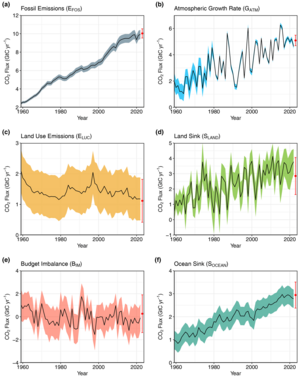 OceansOcean acidificationCarbon dioxide dissolves in the ocean to form carbonic acid (H2CO3), bicarbonate (HCO−3), and carbonate (CO2−3). There is about fifty times as much carbon dioxide dissolved in the oceans as exists in the atmosphere. The oceans act as an enormous carbon sink, and have taken up about a third of CO2 emitted by human activity.[90] Ocean acidification is the ongoing decrease in the pH of the Earth's ocean. Between 1950 and 2020, the average pH of the ocean surface fell from approximately 8.15 to 8.05.[91] Carbon dioxide emissions from human activities are the primary cause of ocean acidification, with atmospheric carbon dioxide (CO2) levels exceeding 422 ppm (as of 2024[update]).[92] CO2 from the atmosphere is absorbed by the oceans. This chemical reaction produces carbonic acid (H2CO3) which dissociates into a bicarbonate ion (HCO−3) and a hydrogen ion (H+). The presence of free hydrogen ions (H+) lowers the pH of the ocean, increasing acidity (this does not mean that seawater is acidic yet; it is still alkaline, with a pH higher than 8). Marine calcifying organisms, such as mollusks and corals, are especially vulnerable because they rely on calcium carbonate to build shells and skeletons.[93] A change in pH by 0.1 represents a 26% increase in hydrogen ion concentration in the world's oceans (the pH scale is logarithmic, so a change of one in pH units is equivalent to a tenfold change in hydrogen ion concentration). Sea-surface pH and carbonate saturation states vary depending on ocean depth and location. Colder and higher latitude waters are capable of absorbing more CO2. This can cause acidity to rise, lowering the pH and carbonate saturation levels in these areas. There are several other factors that influence the atmosphere-ocean CO2 exchange, and thus local ocean acidification. These include ocean currents and upwelling zones, proximity to large continental rivers, sea ice coverage, and atmospheric exchange with nitrogen and sulfur from fossil fuel burning and agriculture.[94][95][96]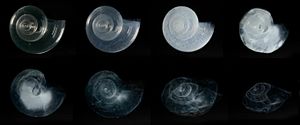 Changes in ocean chemistry can have extensive direct and indirect effects on organisms and their habitats. One of the most important repercussions of increasing ocean acidity relates to the production of shells out of calcium carbonate (CaCO3).[93] This process is called calcification and is important to the biology and survival of a wide range of marine organisms. Calcification involves the precipitation of dissolved ions into solid CaCO3 structures, structures for many marine organisms, such as coccolithophores, foraminifera, crustaceans, mollusks, etc. After they are formed, these CaCO3 structures are vulnerable to dissolution unless the surrounding seawater contains saturating concentrations of carbonate ions (CO2−3). Very little of the extra carbon dioxide that is added into the ocean remains as dissolved carbon dioxide. The majority dissociates into additional bicarbonate and free hydrogen ions. The increase in hydrogen is larger than the increase in bicarbonate,[97] creating an imbalance in the reaction:
To maintain chemical equilibrium, some of the carbonate ions already in the ocean combine with some of the hydrogen ions to make further bicarbonate. Thus the ocean's concentration of carbonate ions is reduced, removing an essential building block for marine organisms to build shells, or calcify:
Hydrothermal ventsCarbon dioxide is also introduced into the oceans through hydrothermal vents. The Champagne hydrothermal vent, found at the Northwest Eifuku volcano in the Mariana Trench, produces almost pure liquid carbon dioxide, one of only two known sites in the world as of 2004, the other being in the Okinawa Trough.[98] The finding of a submarine lake of liquid carbon dioxide in the Okinawa Trough was reported in 2006.[99] SourcesThe burning of fossil fuels for energy produces 36.8 billion tonnes of CO2 per year as of 2023.[100] Nearly all of this goes into the atmosphere, where approximately half is subsequently absorbed into natural carbon sinks.[101] Less than 1% of CO2 produced annually is put to commercial use.[18]: 3 Biological processesCarbon dioxide is a by-product of the fermentation of sugar in the brewing of beer, whisky and other alcoholic beverages and in the production of bioethanol. Yeast metabolizes sugar to produce CO2 and ethanol, also known as alcohol, as follows:
All aerobic organisms produce CO2 when they oxidize carbohydrates, fatty acids, and proteins. The large number of reactions involved are exceedingly complex and not described easily. Refer to cellular respiration, anaerobic respiration and photosynthesis. The equation for the respiration of glucose and other monosaccharides is:
Anaerobic organisms decompose organic material producing methane and carbon dioxide together with traces of other compounds.[102] Regardless of the type of organic material, the production of gases follows well defined kinetic pattern. Carbon dioxide comprises about 40–45% of the gas that emanates from decomposition in landfills (termed "landfill gas"). Most of the remaining 50–55% is methane.[103] CombustionThe combustion of all carbon-based fuels, such as methane (natural gas), petroleum distillates (gasoline, diesel, kerosene, propane), coal, wood and generic organic matter produces carbon dioxide and, except in the case of pure carbon, water. As an example, the chemical reaction between methane and oxygen:
Iron is reduced from its oxides with coke in a blast furnace, producing pig iron and carbon dioxide:[104]
By-product from hydrogen productionCarbon dioxide is a byproduct of the industrial production of hydrogen by steam reforming and the water gas shift reaction in ammonia production. These processes begin with the reaction of water and natural gas (mainly methane).[105] Thermal decomposition of limestoneIt is produced by thermal decomposition of limestone, CaCO3 by heating (calcining) at about 850 °C (1,560 °F), in the manufacture of quicklime (calcium oxide, CaO), a compound that has many industrial uses:
Acids liberate CO2 from most metal carbonates. Consequently, it may be obtained directly from natural carbon dioxide springs, where it is produced by the action of acidified water on limestone or dolomite. The reaction between hydrochloric acid and calcium carbonate (limestone or chalk) is shown below:
The carbonic acid (H2CO3) then decomposes to water and CO2:
Such reactions are accompanied by foaming or bubbling, or both, as the gas is released. They have widespread uses in industry because they can be used to neutralize waste acid streams. Commercial uses Around 230 Mt of CO2 are used each year,[107] mostly in the fertiliser industry for urea production (130 million tonnes) and in the oil and gas industry for enhanced oil recovery (70 to 80 million tonnes).[18]: 3 Other commercial applications include food and beverage production, metal fabrication, cooling, fire suppression and stimulating plant growth in greenhouses.[18]: 3 Technology exists to capture CO2 from industrial flue gas or from the air. Research is ongoing on ways to use captured CO2 in products and some of these processes have been deployed commercially.[108] However, the potential to use products is very small compared to the total volume of CO2 that could foreseeably be captured.[109] The vast majority of captured CO2 is considered a waste product and sequestered in underground geologic formations.[110] Precursor to chemicalsIn the chemical industry, carbon dioxide is mainly consumed as an ingredient in the production of urea, with a smaller fraction being used to produce methanol and a range of other products.[111] Some carboxylic acid derivatives such as sodium salicylate are prepared using CO2 by the Kolbe–Schmitt reaction.[112] Captured CO2 could be to produce methanol or electrofuels. To be carbon-neutral, the CO2 would need to come from bioenergy production or direct air capture.[113]: 21–24 Fossil fuel recoveryCarbon dioxide is used in enhanced oil recovery where it is injected into or adjacent to producing oil wells, usually under supercritical conditions, when it becomes miscible with the oil. This approach can increase original oil recovery by reducing residual oil saturation by 7–23% additional to primary extraction.[114] It acts as both a pressurizing agent and, when dissolved into the underground crude oil, significantly reduces its viscosity, and changing surface chemistry enabling the oil to flow more rapidly through the reservoir to the removal well.[115] Most CO2 injected in CO2-EOR projects comes from naturally occurring underground CO2 deposits.[116] Some CO2 used in EOR is captured from industrial facilities such as natural gas processing plants, using carbon capture technology and transported to the oilfield in pipelines.[116] AgriculturePlants require carbon dioxide to conduct photosynthesis. The atmospheres of greenhouses may (if of large size, must) be enriched with additional CO2 to sustain and increase the rate of plant growth.[117][118] At very high concentrations (100 times atmospheric concentration, or greater), carbon dioxide can be toxic to animal life, so raising the concentration to 10,000 ppm (1%) or higher for several hours will eliminate pests such as whiteflies and spider mites in a greenhouse.[119] Some plants respond more favorably to rising carbon dioxide concentrations than others, which can lead to vegetation regime shifts like woody plant encroachment.[120] Foods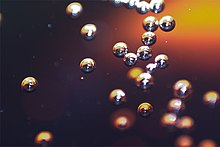 Carbon dioxide is a food additive used as a propellant and acidity regulator in the food industry. It is approved for usage in the EU[121] (listed as E number E290), US,[122] Australia and New Zealand[123] (listed by its INS number 290). A candy called Pop Rocks is pressurized with carbon dioxide gas[124] at about 4,000 kPa (40 bar; 580 psi). When placed in the mouth, it dissolves (just like other hard candy) and releases the gas bubbles with an audible pop. Leavening agents cause dough to rise by producing carbon dioxide.[125] Baker's yeast produces carbon dioxide by fermentation of sugars within the dough, while chemical leaveners such as baking powder and baking soda release carbon dioxide when heated or if exposed to acids. BeveragesCarbon dioxide is used to produce carbonated soft drinks and soda water. Traditionally, the carbonation of beer and sparkling wine came about through natural fermentation, but many manufacturers carbonate these drinks with carbon dioxide recovered from the fermentation process. In the case of bottled and kegged beer, the most common method used is carbonation with recycled carbon dioxide. With the exception of British real ale, draught beer is usually transferred from kegs in a cold room or cellar to dispensing taps on the bar using pressurized carbon dioxide, sometimes mixed with nitrogen. The taste of soda water (and related taste sensations in other carbonated beverages) is an effect of the dissolved carbon dioxide rather than the bursting bubbles of the gas. Carbonic anhydrase 4 converts carbon dioxide to carbonic acid leading to a sour taste, and also the dissolved carbon dioxide induces a somatosensory response.[126] Winemaking Carbon dioxide in the form of dry ice is often used during the cold soak phase in winemaking to cool clusters of grapes quickly after picking to help prevent spontaneous fermentation by wild yeast. The main advantage of using dry ice over water ice is that it cools the grapes without adding any additional water that might decrease the sugar concentration in the grape must, and thus the alcohol concentration in the finished wine. Carbon dioxide is also used to create a hypoxic environment for carbonic maceration, the process used to produce Beaujolais wine. Carbon dioxide is sometimes used to top up wine bottles or other storage vessels such as barrels to prevent oxidation, though it has the problem that it can dissolve into the wine, making a previously still wine slightly fizzy. For this reason, other gases such as nitrogen or argon are preferred for this process by professional wine makers. Stunning animalsCarbon dioxide is often used to "stun" animals before slaughter.[127] "Stunning" may be a misnomer, as the animals are not knocked out immediately and may suffer distress.[128][129] Inert gasCarbon dioxide is one of the most commonly used compressed gases for pneumatic (pressurized gas) systems in portable pressure tools. Carbon dioxide is also used as an atmosphere for welding, although in the welding arc, it reacts to oxidize most metals. Use in the automotive industry is common despite significant evidence that welds made in carbon dioxide are more brittle than those made in more inert atmospheres.[130] When used for MIG welding, CO2 use is sometimes referred to as MAG welding, for Metal Active Gas, as CO2 can react at these high temperatures. It tends to produce a hotter puddle than truly inert atmospheres, improving the flow characteristics. Although, this may be due to atmospheric reactions occurring at the puddle site. This is usually the opposite of the desired effect when welding, as it tends to embrittle the site, but may not be a problem for general mild steel welding, where ultimate ductility is not a major concern. Carbon dioxide is used in many consumer products that require pressurized gas because it is inexpensive and nonflammable, and because it undergoes a phase transition from gas to liquid at room temperature at an attainable pressure of approximately 60 bar (870 psi; 59 atm), allowing far more carbon dioxide to fit in a given container than otherwise would. Life jackets often contain canisters of pressured carbon dioxide for quick inflation. Aluminium capsules of CO2 are also sold as supplies of compressed gas for air guns, paintball markers/guns, inflating bicycle tires, and for making carbonated water. High concentrations of carbon dioxide can also be used to kill pests. Liquid carbon dioxide is used in supercritical drying of some food products and technological materials, in the preparation of specimens for scanning electron microscopy[131] and in the decaffeination of coffee beans. Fire extinguisher Carbon dioxide can be used to extinguish flames by flooding the environment around the flame with the gas. It does not itself react to extinguish the flame, but starves the flame of oxygen by displacing it. Some fire extinguishers, especially those designed for electrical fires, contain liquid carbon dioxide under pressure. Carbon dioxide extinguishers work well on small flammable liquid and electrical fires, but not on ordinary combustible fires, because they do not cool the burning substances significantly, and when the carbon dioxide disperses, they can catch fire upon exposure to atmospheric oxygen. They are mainly used in server rooms.[132] Carbon dioxide has also been widely used as an extinguishing agent in fixed fire-protection systems for local application of specific hazards and total flooding of a protected space.[133] International Maritime Organization standards recognize carbon dioxide systems for fire protection of ship holds and engine rooms. Carbon dioxide-based fire-protection systems have been linked to several deaths, because it can cause suffocation in sufficiently high concentrations. A review of CO2 systems identified 51 incidents between 1975 and the date of the report (2000), causing 72 deaths and 145 injuries.[134] Supercritical CO2 as solventLiquid carbon dioxide is a good solvent for many lipophilic organic compounds and is used to decaffeinate coffee.[135] Carbon dioxide has attracted attention in the pharmaceutical and other chemical processing industries as a less toxic alternative to more traditional solvents such as organochlorides. It is also used by some dry cleaners for this reason. It is used in the preparation of some aerogels because of the properties of supercritical carbon dioxide. Refrigerant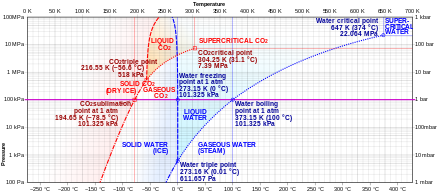 Liquid and solid carbon dioxide are important refrigerants, especially in the food industry, where they are employed during the transportation and storage of ice cream and other frozen foods. Solid carbon dioxide is called "dry ice" and is used for small shipments where refrigeration equipment is not practical. Solid carbon dioxide is always below −78.5 °C (−109.3 °F) at regular atmospheric pressure, regardless of the air temperature. Liquid carbon dioxide (industry nomenclature R744 or R-744) was used as a refrigerant prior to the use of dichlorodifluoromethane (R12, a chlorofluorocarbon (CFC) compound).[136] CO2 might enjoy a renaissance because one of the main substitutes to CFCs, 1,1,1,2-tetrafluoroethane (R134a, a hydrofluorocarbon (HFC) compound) contributes to climate change more than CO2 does. CO2 physical properties are highly favorable for cooling, refrigeration, and heating purposes, having a high volumetric cooling capacity. Due to the need to operate at pressures of up to 130 bars (1,900 psi; 13,000 kPa), CO2 systems require highly mechanically resistant reservoirs and components that have already been developed for mass production in many sectors. In automobile air conditioning, in more than 90% of all driving conditions for latitudes higher than 50°, CO2 (R744) operates more efficiently than systems using HFCs (e.g., R134a). Its environmental advantages (GWP of 1, non-ozone depleting, non-toxic, non-flammable) could make it the future working fluid to replace current HFCs in cars, supermarkets, and heat pump water heaters, among others. Coca-Cola has fielded CO2-based beverage coolers and the U.S. Army is interested in CO2 refrigeration and heating technology.[137][138] Minor uses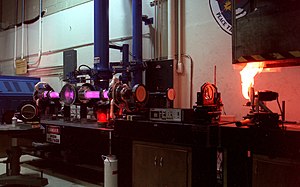 Carbon dioxide is the lasing medium in a carbon-dioxide laser, which is one of the earliest type of lasers. Carbon dioxide can be used as a means of controlling the pH of swimming pools,[139] by continuously adding gas to the water, thus keeping the pH from rising. Among the advantages of this is the avoidance of handling (more hazardous) acids. Similarly, it is also used in the maintaining reef aquaria, where it is commonly used in calcium reactors to temporarily lower the pH of water being passed over calcium carbonate in order to allow the calcium carbonate to dissolve into the water more freely, where it is used by some corals to build their skeleton. Used as the primary coolant in the British advanced gas-cooled reactor for nuclear power generation. Carbon dioxide induction is commonly used for the euthanasia of laboratory research animals. Methods to administer CO2 include placing animals directly into a closed, prefilled chamber containing CO2, or exposure to a gradually increasing concentration of CO2. The American Veterinary Medical Association's 2020 guidelines for carbon dioxide induction state that a displacement rate of 30–70% of the chamber or cage volume per minute is optimal for the humane euthanasia of small rodents.[140]: 5, 31 Percentages of CO2 vary for different species, based on identified optimal percentages to minimize distress.[140]: 22 Carbon dioxide is also used in several related cleaning and surface-preparation techniques. History of discovery Carbon dioxide was the first gas to be described as a discrete substance. In about 1640,[141] the Flemish chemist Jan Baptist van Helmont observed that when he burned charcoal in a closed vessel, the mass of the resulting ash was much less than that of the original charcoal. His interpretation was that the rest of the charcoal had been transmuted into an invisible substance he termed a "gas" (from Greek "chaos") or "wild spirit" (spiritus sylvestris).[142] The properties of carbon dioxide were further studied in the 1750s by the Scottish physician Joseph Black. He found that limestone (calcium carbonate) could be heated or treated with acids to yield a gas he called "fixed air". He observed that the fixed air was denser than air and supported neither flame nor animal life. Black also found that when bubbled through limewater (a saturated aqueous solution of calcium hydroxide), it would precipitate calcium carbonate. He used this phenomenon to illustrate that carbon dioxide is produced by animal respiration and microbial fermentation. In 1772, English chemist Joseph Priestley published a paper entitled Impregnating Water with Fixed Air in which he described a process of dripping sulfuric acid (or oil of vitriol as Priestley knew it) on chalk in order to produce carbon dioxide, and forcing the gas to dissolve by agitating a bowl of water in contact with the gas.[143] Carbon dioxide was first liquefied (at elevated pressures) in 1823 by Humphry Davy and Michael Faraday.[144] The earliest description of solid carbon dioxide (dry ice) was given by the French inventor Adrien-Jean-Pierre Thilorier, who in 1835 opened a pressurized container of liquid carbon dioxide, only to find that the cooling produced by the rapid evaporation of the liquid yielded a "snow" of solid CO2.[145][146] Carbon dioxide in combination with nitrogen was known from earlier times as Blackdamp, stythe or choke damp.[b] Along with the other types of damp it was encountered in mining operations and well sinking. Slow oxidation of coal and biological processes replaced the oxygen to create a suffocating mixture of nitrogen and carbon dioxide.[147] See also
NotesReferences
External linksWikimedia Commons has media related to Carbon dioxide. |
||||||||||||||||||||||||||||||||||||||||||||||||||||||||||||||||||||||||||||||||||||||||||||||||||||||||||||||||||||||||||||||||||||||||||||||||||||||||||||||||||||||||||||||||||||||||||||||||||||||||||||||||||||||||||||||||||||||||||||||||||||||||||||||||||||||||||||||||||||||||||||||||||||||||||||||||||||||||||||||||||||||||||||||||||||||||||||




![{\displaystyle K_{\mathrm {h} }={\frac {{\ce {[H2CO3]}}}{{\ce {[CO2_{(aq)}]}}}}=1.70\times 10^{-3}}](https://wikimedia.org/api/rest_v1/media/math/render/svg/7b01be634ec0c3d83cbf3aa2c71bbd51b9ce0e26)
![{\displaystyle K_{\mathrm {a1} }={\frac {{\ce {[HCO3- ][H+]}}}{{\ce {[H2CO3]}}}}}](https://wikimedia.org/api/rest_v1/media/math/render/svg/f6013fac05dba06751345e4d824c525ed2c43b12)
![{\displaystyle K_{\mathrm {a1} }{\rm {(apparent)}}={\frac {{\ce {[HCO3- ][H+]}}}{{\ce {[H2CO3] + [CO2_{(aq)}]}}}}}](https://wikimedia.org/api/rest_v1/media/math/render/svg/3ae2fa07440c037d6054ce4e7ef95c15c59264e7)

